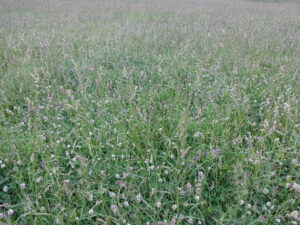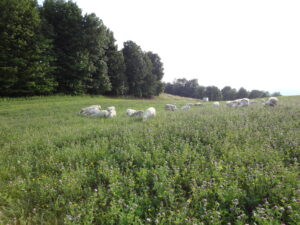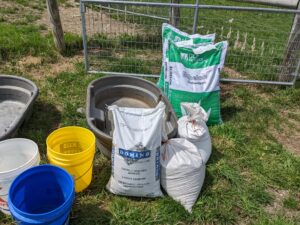Pasture Mix for Sheep
What grass and legume species are liked by sheep and are easily established?
A recurring question I receive is the one of what grass and legume species to choose when a pasture is being reseeded. Exotic names are being tossed around and I am being asked my opinion. Pasture mixes that are offered by various seed companies are often containing seed of grass species I have found subpar for grazing sheep. In this article I will address what has worked best for me and perhaps spare you the disappointment of something exotic either not growing or not being much liked by sheep. Keep in mind that your climate zone needs to be similar to mine if you want to heed my advice.

Orchard grass and New Zealand grazing white clover are two of the three dominant forage species in my pasture. Ulf Kintzel / White Clover Sheep Farm
It has been almost 17 years that I am farming at this new location of White Clover Sheep Farm. At our arrival here in Western New York not all of the purchased 100 acres of farmland was ready to be grazed. For instance, I had to reseed a seven-acre field of pumpkins into pasture. I turned this necessity into an opportunity and made this my very own test plot. I planted strips of late-heading orchard grass, rye grass, meadow fescue, a soft-leafed tall fescue, a more erect growing blue grass variety, and, after I ran out of seed and still had some area to be seeded, timothy. After grazing this plot for many years, I had one grass species and two legume species as winners. Some of the grass species were not satisfactory. The species were either not hardy enough (meadow fescue) or were not much liked by the sheep (the soft-leaved and improved tall fescue) or needed more input to bring any acceptable yield (rye grass) or simply became irrelevant (blue grass). The one and only grass species that met and exceeded expectations on many levels was the late heading orchard grass. What’s more, the sheep over time spread the orchard grass throughout that field by collecting seed in their wool and hair and transferring it to new areas. Where other grass species had failed, the orchard grass was taking its place.
The legumes I tried in my seven-acre “test plot” that used to be a pumpkin field were a New Zealand grazing white clover, medium red clover, birdsfoot trefoil, and Kura clover. The Kura clover was a failure right from the beginning. Very few plants developed. The ones that did develop were not grazed as willingly as other legume and grass species. The birdsfoot trefoil developed strongly but did not take the grazing well and the stand was diminished with each passing year. The medium red clover developed strongly and offered high yields. However, since red clover is a bi-annual, it needs to be reseeded from time to time, which I do when I frost-seed pasture in the spring. The New Zealand grazing white clover was a new experience for me at that time. It became the clear winner among the legumes. A thick stand developed and, since white clover is a perennial, has persisted over the entire time that we have been here.
Other areas of the farm had been simply neglected when we arrived 16 years ago. Weeds, mostly Canadian golden rod, and bushes of Tartarian honey suckle and multiflora rose had started growing. I simply grazed and then bush-hogged these fields. At that time, there was no money left to plow these fields up. A young family of five, a new farm with a mortgage, and other priorities left me without additional funds to be spent on more seed. Over time, “native” orchard grass moved in, the seeds spread by the sheep, carrying them in their hair and wool. (I put native in quotes because orchard grass is an old-world grass species but any old variety that volunteered and is unimproved is commonly referred to as native.)
The established main hay fields consisted mostly of timothy and were quite depleted of nutrients. Here too native orchard grass started to move in and after a few years of rotational grazing became the dominant grass species. Likewise, some clearings where I had cut brush and saplings started showing a lush stand of orchard grass after just a few years of grazing.

Red clover has the added benefit of being relatively drought resistant. Ulf Kintzel / White Clover Sheep Farm
An adjacent 15-acre weedy field, growing mostly golden rod and owned by an absentee landowner, also needed to be reseeded. I did so after I secured a long-term lease. Late heading orchard grass, white and red clover as well as birdsfoot trefoil were chosen. The orchard grass and the clovers did well again and still do after more than a decade but the birdsfoot trefoil suffered the same destiny as the one in my reseeded pumpkin field. After an initial beautiful stand, it slowly disappeared, not enduring the grazing. Ironically, birdsfoot trefoil is described as long-lived but didn’t live long in my pasture. On the other hand, New Zealand grazing white clover is supposed to have limited longevity and yet, all my white clover stands are thriving, some of them being up to 15 years old. Red clover is considered a bi-annual but under a proper rotational grazing management system it will get plenty opportunity to reseed itself and maintain a good stand. Yet, reseeding it from time to time by means of frost-seeding is a good idea to thicken the stand.

Preparing my own pasture mix: a late heading orchard grass, NZ grazing white clover, and locally grown medium red clover. Ulf Kintzel / White Clover Sheep Farm
Last year it was eventually time to plow up and reseed a field that was finally fully tiled but consisted of a lot of tall fescue, which had volunteered in the many spots that had been previously wet and deprived of oxygen. It also had just too many Canadian thistles. The fescue and weeds made it simply too unproductive. My first inclination was to seed a late-heading orchard grass, which gives me an additional two weeks’ time for haying in early spring. In addition, I planned on using one of my successfully growing New Zealand grazing white clovers, mixed 50/50 with locally grown medium red clover. Then I started to think and asked myself if that was really the right choice. I had a chance to start over with a 12-acre plot. Who knows if I get that change again anytime soon during my remaining years of farming? After serious deliberation with myself I arrived at the starting point, thinking to myself ‘Why would you try something else if orchard grass and white and red clover grow so easily at your farm, yield so much, and are so much liked by your sheep?’ So, a late-heading orchard grass variety, a New Zealand grazing white clover, and medium red clover are the three pasture species of choice for me and the ones I recommend. That is my final answer.

